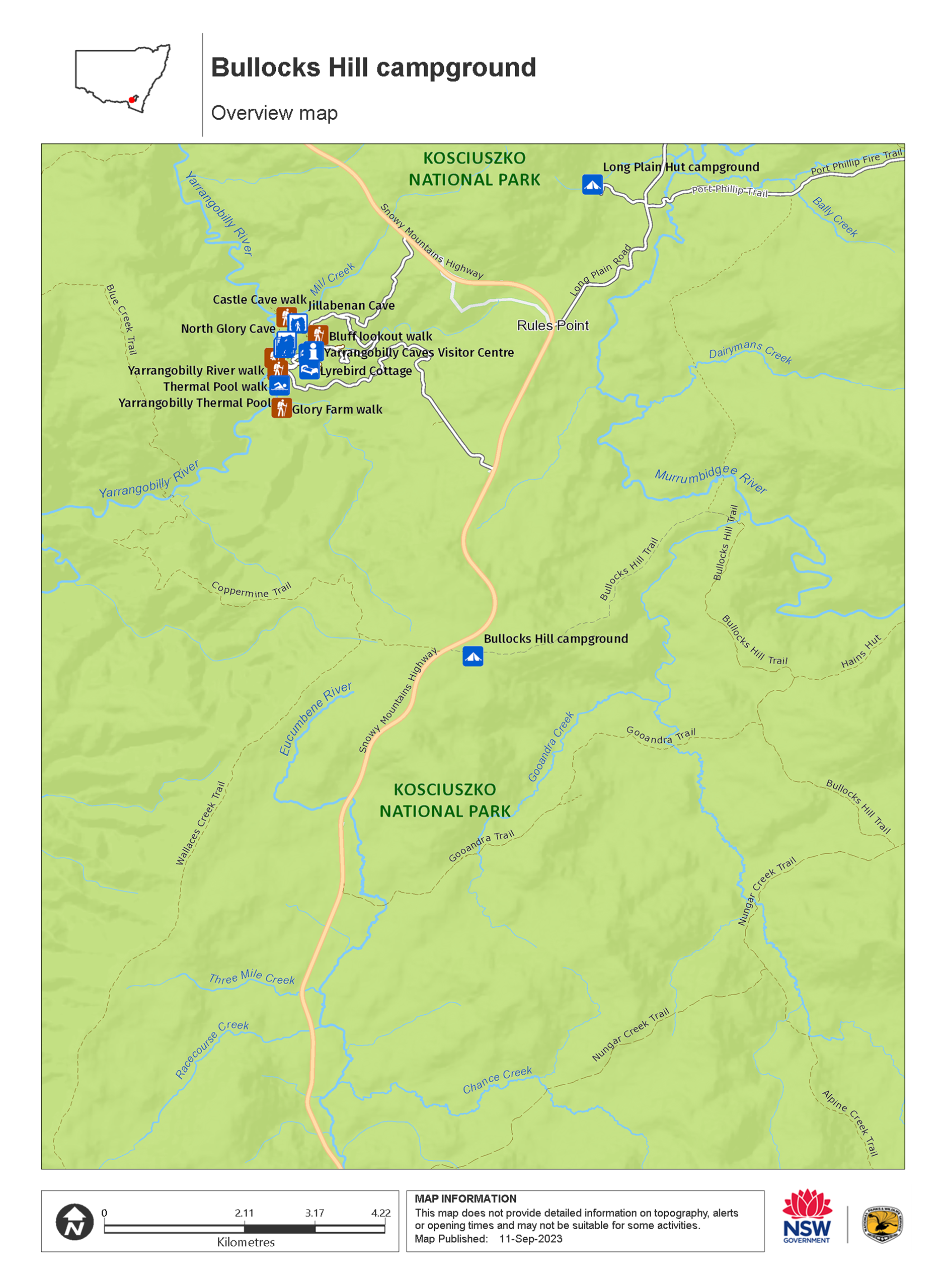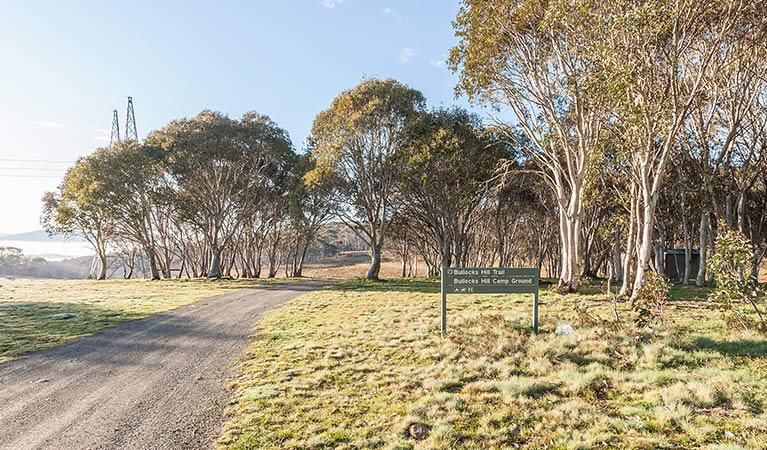Bullocks Hill campground
Selwyn area in Kosciuszko National Park
Overview
Bullocks Hill campground is a great summer base for horse riding, mountain biking, fishing and bushwalking in northern Kosciuszko National Park, between Kiandra and Yarrangobilly Caves.
| Camping type | Tent, Camper trailer site, Caravan site, Camping beside my vehicle , Camping with horses |
|---|---|
| Facilities | Barbecue facilities, carpark, toilets |
| What to bring | Drinking water, cooking water |
| Opening times | Closed from June long weekend to October long weekend. |
| Group bookings | Book up to 20 people or 5 sites online. For larger groups, make a group booking enquiry. |
| Please note |
|
Nestled among sub-alpine plains and frost hollows, just off Snowy Mountains Highway, Bullocks Hill campground is a great base to explore northern Kosciuszko National Park.
The campground’s a popular place for camping with horses, with a horse yard onsite. Saddle up and explore the trails and high country huts including Millers Hut to the north, and Witzes Hut further along Bullocks Hill trail. The cool climate makes it ideal for bushwalking and mountain biking in summer.
Watch for kangaroos and wallabies bounding across the open plains, as the unmistakable ‘squeaky gate’ sounds of gang-gang cockatoos echo above. You might see pipit birds foraging on the ground and darting out of the grassy woodlands.
Why not take a scenic drive to discover the huts and heritage along Long Plain and Blue Waterholes? Yarrangobilly Caves is a short drive up the highway. Or, spend your days fishing for trout in the Murrumbidgee and Eucumbene Rivers, or Tantangara Dam.
Autumn brings cold nights, perfect for a campfire. While there’s no access in winter, it’s worth visiting in spring, when the plains bloom with purple hovea, orange shaggy peas, and yellow billy buttons.
Map

Map legend

Local alerts
For the latest updates on fires, closures and other alerts in this area, see https://uat.nswparks.cloud/camping-and-accommodation/campgrounds/bullocks-hill-campground/local-alerts
Bookings
- National Parks Contact Centre
- 7am to 7pm daily
- 1300 072 757 (13000 PARKS) for the cost of a local call within Australia excluding mobiles
- parks.info@environment.nsw.gov.au
Operated by
- Tumut Region Visitor Centre
- 9am to 5pm daily. Closed Christmas Day.
- 02 6947 7025
- tumutrvc@environment.nsw.gov.au
- The Old Butter Factory, 5 Adelong Road, Tumut NSW 2720
Park info
- in the Selwyn area of Kosciuszko National Park in the Snowy Mountains region
The Selwyn area is open all year, but some roads and trails may close due to weather conditions or park management issues. Kings Cross Road and the Khancoban-Cabramurra Road are closed in winter (June to October long weekends). Some campgrounds in the Selwyn area close in winter.
-
Park entry fees apply in winter on Link Road
June to October long weekends: $29 per vehicle per day (24hrs from purchase); motorcycles $12; bus passengers $11.45 per adult, $3.60 per child per day (24hrs). Single and Multi-Day passes available from entry stations, NPWS visitor centres, pay machines or via the Park'nPay app.
See vehicle entry fees for other areas in Kosciuszko National Park.
Buy annual pass.
Visitor info
All the practical information you need to know about Bullocks Hill campground.
Maps and downloads
Learn more
Bullocks Hill campground is in Selwyn area. Here are just some of the reasons why this park is special:
Kiandra's claims to fame

The discovery of gold at Kiandra in 1859 attracted up to 10,000 prospectors hoping to strike it rich. Just 18 months later, after harsh winters and falling gold finds, only a few hundred gold miners remained. It's remembered as one of Australia’s shortest gold rushes, not to mention it’s highest (and coldest). In 1861, Kiandra became the birthplace of skiing in Australia, when Norwegian gold miners fashioned skis from fence palings. By the 1870s regular ski carnivals were arranged, and Australia had its first official ski slope here. Mining continued into the 1930s, with grazing and winter skiing also keeping the community alive. Before devastating fires in 2019-2020, four buildings still stood here, including Kiandra Courthouse, which had served as a courthouse, private residence, ski chalet, hotel and bar.
Plants and animals protected in this park
Animals
-

Bare-nosed wombat (Vombatus ursinus)
A large, squat marsupial, the Australian bare-nosed wombat is a burrowing mammal found in coastal forests and mountain ranges across NSW and Victoria. The only other remaining species of wombat in NSW, the endangered southern hairy-nosed wombat, was considered extinct until relatively recently.
-

Platypus (Ornithorhynchus anatinus)
One of the most fascinating and unusual Australian animals, the duck-billed platypus, along with the echidna, are the only known monotremes, or egg-laying mammals, in existence. The platypus is generally found in permanent river systems and lakes in southern and eastern NSW and east and west of the Great Dividing Range.
-

Wedge-tailed eagle (Aquila audax)
With a wingspan of up to 2.5m, the wedge-tailed eagle is Australia’s largest bird of prey. These Australian animals are found in woodlands across NSW, and have the ability to soar to heights of over 2km. If you’re bird watching, look out for the distinctive diamond-shaped tail of the eagle.
Plants
-

Billy buttons (Craspedia spp. )
Billy buttons are attractive Australian native plants that are widespread throughout eastern NSW in dry forest, grassland and alpine regions such as Kosciuszko National Park. The golden-yellow globe-shaped flowers are also known as woollyheads. Related to the daisy, billy buttons are an erect herb growing to a height of 50cm.

